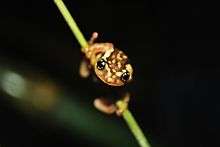Raorchestes ochlandrae
| Raorchestes ochlandrae | |
|---|---|
 | |
| Scientific classification | |
| Kingdom: | Animalia |
| Phylum: | Chordata |
| Class: | Amphibia |
| Order: | Anura |
| Family: | Rhacophoridae |
| Subfamily: | Rhacophorinae |
| Genus: | Raorchestes |
| Species: | R. ochlandrae |
| Binomial name | |
| Raorchestes ochlandrae (Gururaja, Dinesh, Palot, Radhakrishnan, and Ramachandra, 2007) | |
| Synonyms | |
|
Philautus ochlandrae Gururaja, Dinesh, Palot, Radhakrishnan, and Ramachandra, 2007[2] | |
Raorchestes ochlandrae (common name: Ochlandrae reed frog) is a species of shrub frog in the family Rhacophoridae.[2][3][4] It is endemic to the Western Ghats, India. This species of the oriental shrub frog was described from Kakkayam Reserve Forest of Calicut district, Kerala state, in the southern Western Ghats in 2007;[2] it is not yet known from elsewhere.[3] The specific name ochlandrae refers to microhabitat of the species, bamboo Ochlandra setigera.[2]
Description
Males measure 22–26 mm (0.87–1.02 in) and females, based on only one measured specimen, 23 mm (0.91 in) in snout–vent length. The female was observed in amplexus and was larger than the male it was paired with.[2]
This species is distinguished from congeners by the combination of characters such as body small, elongate, squat and flat; head arched, wider than long; snout short rounded, equal or sub equal to diameter of eye; canthus rostralis rounded; tympanum indistinct but visible; eyes protruding, pupil with striking golden yellow dentition like marks; belly granular; vocal sac unpigmented; fleshy brown to cream yellow dorsum with two distinct golden yellow lateral bands bordered by dark brown from upper eyelid to the posterior part of flanks.[2]

Habitat and conservation
This species inhabits dense stands of the bamboo Ochlandra setigera, growing on forest edges and in more in open habitats. The frogs reside in the hollow tube of internodal region of bamboo about two to three metres above the ground.[1][2]
The species occurs in the Kakkayam Forest Reserve Reserve, although the reserve is being fragmented by dam construction and related activities (clearing of forest for access roads, power lines, and pipelines). Also bamboo stands have been cut for temporary shelters and for fuel. Nevertheless, Raorchestes ochlandrae seems to be able to survive wherever Ochlandra stands remain.[1]
References
- 1 2 3 K.V. Gururaja (2008). "Raorchestes ochlandrae". IUCN Red List of Threatened Species. Version 2014.2. International Union for Conservation of Nature. Retrieved 10 November 2013.
- 1 2 3 4 5 6 7 Gururaja, K. V.; Dinesh, K. P.; Palot, M. J.; Radhakrishnan, C.; Ramachandra, T. V. (2007). "A new species of Philautus Gistel (Amphibia: Anura: Rhacophoridae) from southern Western Ghats, India". Zootaxa. 1621: 1–16.
- 1 2 Frost, Darrel R. (2016). "Raorchestes ochlandrae (Gururaja, Dinesh, Palot, Radhakrishnan, and Ramachandra, 2007)". Amphibian Species of the World: an Online Reference. Version 6.0. American Museum of Natural History. Retrieved 24 September 2016.
- ↑ "Raorchestes ochlandrae". AmphibiaWeb: Information on amphibian biology and conservation. [web application]. Berkeley, California: AmphibiaWeb. 2016. Retrieved 24 September 2016.
External links
| Wikimedia Commons has media related to Raorchestes ochlandrae. |
